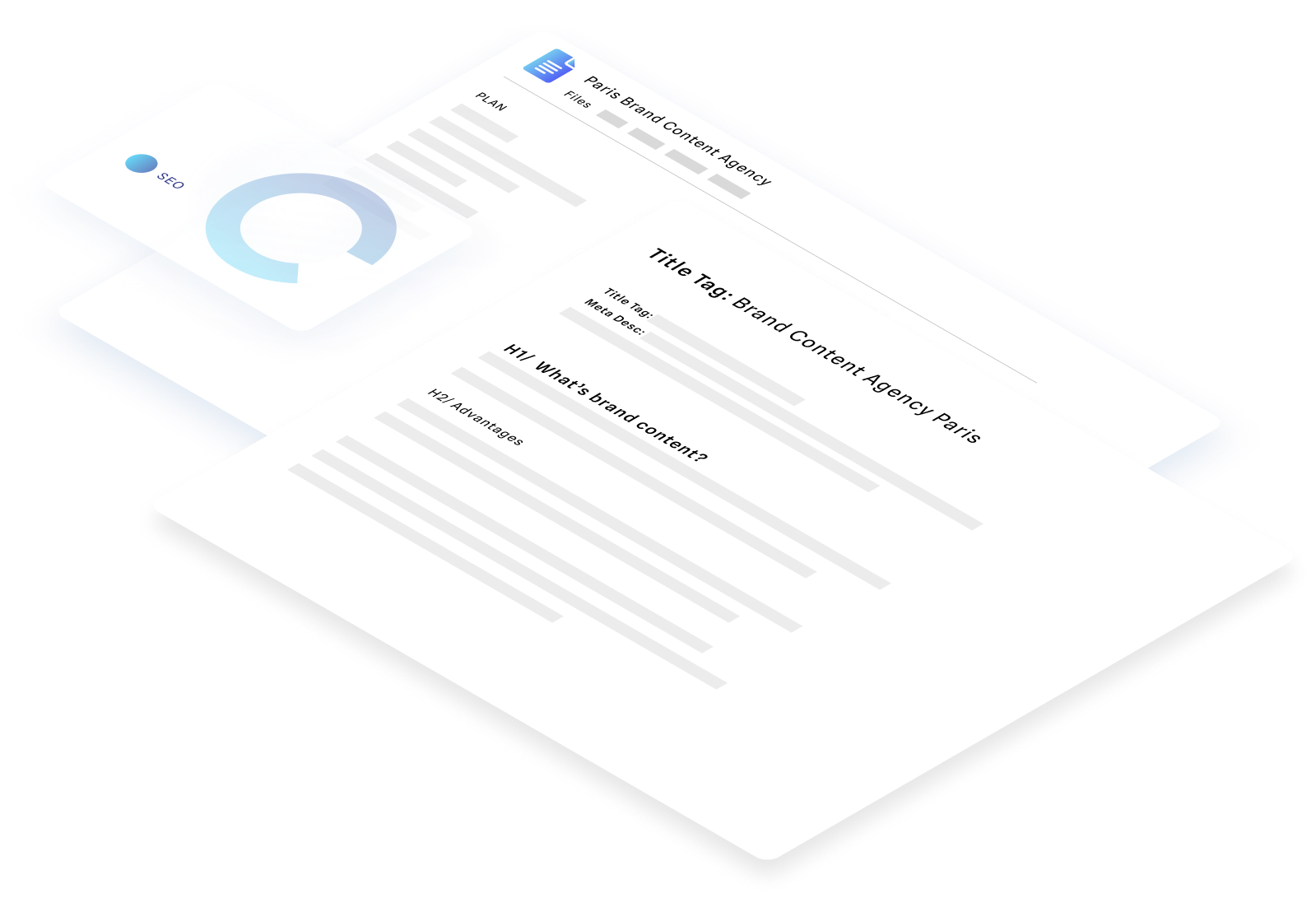
SEO Content: The Main Rules for Writing Optimised Content
To reach the top positions on Google, you need to write high-quality, optimised content. In this guide, you’ll learn how to create effective SEO content.

Why Create SEO-Optimised Content?
What Is SEO Content?
The term “SEO content” refers to content that is optimised for search engines. The goal is to have it appear higher in the search results (the SERP) in order to generate qualified traffic. This type of content should be created with users in mind, encouraging them to click. And yet, it should also keep search engine bots happy. These bots – also known as web crawlers – are in charge of crawling and indexing web pages so the search engine can decide how to rank them. All in all, writing SEO content consists in applying the rules that govern organic search engine optimisation all while providing the users with structured, relevant information. In this guide, we’re going to focus on content optimisation for Google, which tops the global search engine market share at over 90%.
Why Produce SEO-Optimised Content?
There are four main reasons why you may want to write SEO content: visibility, traffic, conversion, and to comply with the guidelines prescribed by search engines.

-
To Gain Visibility on Google
Well-optimised content has the power to place your pages among the top-ranking results (SERP) and boost the visibility of your website, company, and/or brand. When all the conditions are met, SEO content may even reach Position Zero and appear at the very top of the results, as a featured snippet. That’s practically the Holy Grail of SEO!
-
To Generate More Web Traffic
Better SERP visibility equals more traffic. Internet users mainly tend to click the links closest to the top. The first result page monopolises 88% of all clicks, keeping in mind that over half of these (55%) are focused on the first three organic links (Search Engine Journal). If you wish to generate traffic to your website, it is therefore crucial to rank as high as possible in the SERPs.
-
To Gain Better-Qualified Traffic
Generating traffic to your website is good. But converting it is even better. To this end, SEO content plays a part in attracting better targeted – and therefore better qualified – traffic. The users are bound to be interested in the topic being covered, since they performed a specific search and chose to click on a link that seemed likely to meet their expectations. This is how content optimisation has the potential to improve the quality of the traffic being generated.
-
To Comply With Google’s Guidelines
Never forget that Google is watching you. Any content that doesn’t comply with SEO writing guidelines not only runs the risk of going completely unnoticed, but may also be penalised (Panda when it comes to content quality, Penguin for fraudulent SEO practices, etc.). This could result in the website falling down the rankings. Writing SEO content is a way to make sure you observe Google’s guidelines.
SEO Optimisation Isn’t Just About Content!
As important as producing SEO content may be, it is just as crucial to understand that this approach won’t be enough on its own. The creation of optimised content should be seen as part of a broader search engine optimisation strategy. This strategy should be applied to every component of the website and should address the technical side of website building, the website’s architecture, the topics being covered, link building, etc. And let’s not forget about user experience, which search engines view as essential. A website should offer an intuitive, convenient browsing experience all while ensuring a certain level of technical comfort, particularly on mobile. In essence, good SEO content should be the icing on the cake… not the whole cake!
-
68%
of online experiences
begin with a search engine -
53%
of all the traffic websites receive
is generated by organic search -
93%
of global traffic
comes from Google Search, Google Images, and Google Maps
What Are the Rules for SEO Content Writing?
Creating Content for Google… and for the Users!
If you want to write SEO content that is capable of achieving high rankings in the search results, you need to make sure it will accommodate the web crawlers as well as the users who rely on search engines to access information. The dual purpose makes optimised content creation a much more complex task than it seems, as these two targets have very different expectations, and even different needs. Creating good SEO content is nothing short of a challenge. In this section, we’re going to take a look at the criteria Google uses to assess how SEO-friendly your content is and decide where it should rank in the SERP.

How to Create SEO Content?
Creating optimised content boils down to applying the SEO criteria derived from Google’s guidelines – including the ones the search engine never mentions. What are those criteria?

-
Step 1
Write Quality Content
Google favours content with strong added value. It should provide Internet users with useful, relevant, and lasting information, answering the questions they ask. That’s why SEO content should aim to be informational above all else, though it may also have a promotional dimension, so long as it doesn’t impact the quality and relevance of the page (service pages, product pages, etc.).
-
Step 2
Offer Long-Form Content
SEO content should be designed with Internet users in mind. It’s important to note that their attention span is limited and that they tend to scan, picking out individual sentences and words instead of reading a page from beginning to end. To accommodate this behaviour, texts should be based on an inverted pyramid structure (with the most important information at the top). Devote a great deal of attention to the heading and tagline, and make sure the subheadings are carefully crafted to provide a clear overview of the content.
-
Step 3
Embrace a Web-Oriented Structure
Un contenu SEO doit être conçu pour des internautes dont l’attention est limitée, et qui ont tendance à scanner une page plutôt que de la lire dans son intégralité. Pour s’adapter à ce comportement, il faut adopter une structure en pyramide inversée (les informations principales en premier), accorder beaucoup d’importance au titre et à l’accroche, et travailler avec soin les sous-titres pour qu’ils donnent une vision claire du contenu.
-
Step 4
Work on the Right Keyword Selection
In SEO, keywords are at the very heart of optimisation. They identify the queries as users type them into the search bar, and, when integrated strategically into SEO content, they can make it go up in the search results. Ideally, every piece of content should target a specific query. Given how important this point is, we’ve dedicated part 3 of this guide to it.
-
Step 5
Use Semantic SEO
Keywords aren’t everything. Writing good content also means working on the semantic field surrounding the main topic. This semantic optimisation consists in fleshing out the page by including additional terms known as “co-occurrences” (synonyms, contextual words, etc.) which gravitate around the keyword. This is an effective way to provide the bots with further information through rich, diverse content all while keeping the users’ main query in mind.
-
Step 6
Create a Link Building Strategy
SEO content should contain a few links. These can point to other pages on the same website (this is referred to as “internal linking”) to keep the users there for longer and to bring traffic to various pages. The links can also point to external resources selected for their quality (institutional pages, renowned information websites, Wikipedia pages, etc.). This has a positive impact on the bots.
-
Step 7
Write for the Users
Google clearly states in its SEO writing guidelines that content should be created with the users in mind above all else. This implies that you should write well-structured SEO content, favouring airy, diversified text (including images, bullet points, diagrams, etc.). Keep it educational by focusing on short sentences and accessible language, etc. The benefits? When writing for the users, you’re also writing for the bots!
-
Step 8
Optimise Content Images
Images are an integral part of SEO content… and they play a role in its optimisation. There are two main factors to consider. The first is size and weight (the images should be light enough to allow the page to load quickly). The second is the “Alt” attribute (which should contain the main keyword, allowing the image to be “read” by the bots).
Video:
5 SEO Content Writing Tips
Here are 5 tips to help you write properly optimised content for SEO.
Writing SEO content isn’t as simple as it may seem. Numerous criteria need to be taken into account, and it’s essential to keep both targets in mind at all times when writing content (robots on the one hand, internet users on the other).




How to Find (and Use) SEO Keywords?
Keywords: The Cornerstone of Any SEO Content
Keywords are such an important part of SEO content writing that we feel we must dedicate an entire section of this article to them. Keywords are what allows search engine bots to understand what a page contains and how to index it properly, so that it can be served to Internet users whenever they type in the corresponding query. Thus, if you want your content to show up as a response to a specific question, you need to work this expression into the text itself and add it to the HTML tags. Building the content around the keywords makes it easier to optimise and can boost its positioning, which is why it’s so crucial.

Generic Keywords VS. Long-Tail Keywords
Generic Keywords
- Short: 3 words or fewer
- High search volume
- High competition (difficult to rank)
- Less targeted, less qualified traffic
- Objective: to generate high volumes of traffic and capture your audiences’ attention
VS
Long-Tail Expressions
- Long: 4 words or more
- Low search volume
- Low competition (easier to rank)
- Highly targeted, highly qualified traffic
- Objective: to generate niche traffic and boost your conversion rate
Optimisation:
Integrating the Keywords in your SEO Content
Once you’ve selected your keywords, you need to add them to your SEO content strategically. Here are a few simple rules to apply without reserve and optimise your pages.
-
In the Title Tag
The “title” tag is considered the most important “meta” (displayed in the SERP) tag. Place the keyword at the very beginning and don’t exceed 60 characters overall.
-
In the Description Tag
The “meta description” tag is not an absolutely crucial par of SEO, but it does encourage the users to click. Include your SEO content’s main keyword there once or twice.
-
In the Hn Tags
The “Hn” tags refer to the headings and subheadings. Their role is to structure your SEO content. Include your keywords (main + secondary) in at least one Hn.
-
In the Alt Tags
“Alt” tags are used for naming images and allow Google’s bots to understand how they tie into the content. A single occurrence of the keyword is enough.
-
In a Page’s URL
An optimised URL should contain the main keyword for your SEO content. Make sure to keep your URL relatively short (200 characters, tops) and specific.
-
In the Text Content
Include your keywords strategically in your SEO content. Be sure to work it into the introduction, and then several times throughout the text.
-
In Anchor Text
For internal links, add a keyword corresponding to the query you are working on to the anchor text within the targeted page (for example “SEO content” if the page covers this topic).
-
The 1% Rule
The ideal keyword density for SEO content is generally considered to be 1%. In other words, include about one occurrence of the term for every 100 words.
-
Warning: No Inventories
SEO content should not be a keyword inventory. Use them moderately and always focus on the quality of the content, keeping reader experience in mind.
-
7Bn
searches
are processed by Google every hour -
8%
or so of queries
are expressed as questions -
0,16%
of the most popular queries
monopolise 60% of all searches
Our Commitment
-
Expertise
Since 2010, we have worked with over 2000 clients across 90 countries.
-
Passion
We are a team of passionate, industry-focused individuals who are committed to your success.
-
Performance
We’re committed to implementing a data-driven strategy, making a real impact on your bottom line by providing avenues for growth.
Any questions?
SEO content is content that is optimised for the search engines, the goal being to rank higher in the search results. This type of content is designed to appeal to Internet users as well as to the web crawlers (search engine bots). These crawlers index the content and position it among the results based on Google’s many indexing criteria. Then content itself needs to comply with a certain number of SEO rules all while providing the users with relevant information.
Creating optimised content can help you achieve several objectives. It’s a good way to gain visibility on the search engines thanks to higher rankings in the SERP. This means it not only contributes to generating a higher level of traffic, but also better targeted, and therefore better-qualified traffic. Finally, it’s a prerequisite when it comes to complying with search engine guidelines regarding what they view as high-quality SEO content.
SEO content writing implies that you must keep many criteria in mind. You need to focus on quality and relevance, offer relatively long content, favour a web-oriented structure (short sentences, inverted pyramid structure, etc.), identify the right keywords and use them strategically, perform semantic optimisation, create a link building strategy, optimise images, all while mainly writing for the users themselves. These are the keys to writing optimised content for SEO.












